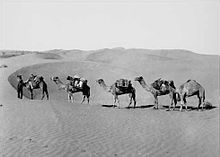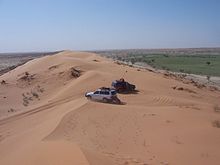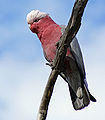Australian deserts
The Australian deserts cover 18 percent of the Australian continent. After the Sahara , Antarctica and Greenland, they are the fourth largest desert area in the world with a size of 1,371,000 km² . The Great Victoria Desert is roughly the size of Germany.
Most of the Australian deserts are uninhabited. In these deserts there are not only classic landscapes with sand, but also an environment that is characterized by mountain and grass landscapes, forests, bushes, rivers and salt lakes .
They are also called hot deserts (German: hot deserts ) because they are characterized by low rainfall and extremely high temperatures and drought. Temperatures reach up to 50 ° C and rainfall less than 250 millimeters per year. The average humidity is between 10 and 20 percent.
Only around 15 percent of the world's deserts consist of sand dune fields. Some of the longest dunes in the world, some hundreds of kilometers long, are located in the Simpson Desert. Sandy deserts are the Great Victoria Sand Desert and Great Sand Desert; Stony Deserts the Gibson and Sturts Stony Deserts.
Deserts
The following table gives an overview of the Australian deserts:
| German name | English name | location | Size in km² |
|---|---|---|---|
| Great Victoria Desert | Great Victoria Desert | South Australia and Western Australia | 348,750 |
| Great sandy desert | Great Sandy Desert | Western Australia and Northern Territory | 267,250 |
| Tanami desert | Tanami Desert | Northern Territory | 184,500 |
| Simpson Desert | Simpson Desert | Central Australia : Northern Territory , Queensland and South Australia | 176,500 |
| Gibson Desert | Gibson Desert | Western Australia | 156,000 |
| Small sand desert | Little Sandy Desert | Western Australia | 111,500 |
| Strzelecki Desert | Strzelecki Desert | South Australia , Queensland and New South Wales | 80,250 |
| Sturt's stony desert | Sturt Stony Desert | South East Australia: South Australia , Queensland and New South Wales | 29,750 |
| Tirari Desert | Tirari Desert | South Australia | 15,250 |
| Pedirka Desert | Pedirka Desert | South Australia | 1,250 |
A large contiguous desert area is formed by the Tanami, Great Sand, Small Sand, Gibson and Great Victoria Sand Deserts in western Australia and a smaller one by the Simpson, Sturt, Strzelecki and Tirari Deserts in the east. The small Pedirka Desert is spatially isolated between Great Victoria Sand and Simpson.
The Western Desert , which describes a cultural region of the indigenous population of Australia, includes the Gibson, Great Victoria, Great Sand and Small Sand Deserts in the states of Northern Territory , South Australia and Western Australia .
European history of discovery

The Strzelecki Desert was named in 1845 by the explorer Charles Sturt after the Polish explorer Paul Edmund Strzelecki .
The first European to cross the Great Sand Desert was Peter Egerton Warburton . He arrived on the coast of Western Australia severely exhausted and blinded in one eye. He owed his survival to Charley, an Aboriginal tracker .
The small sandy desert connects to the large sandy desert and resembles it in terms of its landscape and vegetation.
The name "Great Victoria Desert" was given by the British explorer Ernest Giles , who crossed the desert in 1875. It is dedicated to Queen Victoria .
The Sturt Stony Desert got its name from the British explorer John McDouall Stuart , who first crossed it in 1861. He named the desert after the British explorer Charles Sturt, in whose expeditions he had previously participated.
In 1866 the expedition of Peter Egerton Warburton reached the Tirari Desert coming from the west.
The British explorer Ernest Giles gave the Gibson Desert its name in memory of Alfred Gibson , who went missing during an expedition from 1873 to 1874.
The explorer and prospector Allan Davidson named the Tanami Desert . He only gave the name on his second expedition to this desert area, which ended in 1900. “Tanami” was the original name of the Aborigines for two rock caves with clear drinking water.
The Pedirka desert extends over the geological Pedirka sedimentary basin .
The name of the Simpson Desert goes back to Allen Simpson, a geographer who came into this desert in 1845. The name suggested the explorer and geologist Cecil Madigan . It wasn't until 1936 that Edmund Colson became the first white man to cross the entire Simpson Desert. Previously, the great Australian explorers Charles Sturt and David Lindsay had failed.
Aboriginal

The tribes and clans of the Aborigines have lived nomadically in the desert regions for millennia . They fed on the local flora and fauna, what is now known as bush food , and ensured that their drinking water sources remained intact. The nomads moved in clearly delimited tribal areas. Significant tribes that live in the desert areas are, for example, the Arrernte , Luritja and Pitjantjatjara . The area of influence of the latter tribe extended from Uluṟu to the Nullarbor Plain . The Dieri tribe live in a large area of the Simpson, Strzelecki and Tirari deserts and own land rights over 87,733 square kilometers. Today, numerous Aborigines live in settlements in the deserts.
The remote desert areas remained undeveloped for a long time. The Spinifex People first came into contact with whites in the 1950s when they were expelled from their tribal area for nuclear weapons tests (1950–1963) by the British and Australian governments. The Pintupi Nine , a group of nine Aborigines from the Pintupi tribe , lived in the Gibson Desert in the Stone Age until October 1984 , before they first met whites when they left the desert. Both discoveries were sensations at the time.
Large parts of the Australian desert areas are part of the desert cultural area . For the Aborigines, Uluṟu, located in the desert, and Kata Tjuṯa with their dream time stories are of great cultural importance. The Aborigines of the desert produced numerous important artists, one of the first and best known was Albert Namatjira , who was born in Hermannsburg in the Great Sand Desert.
vegetation
There are two types of grasslands found in the Australian deserts. Tussock or Mitchell grasslands are found in the desert areas of the Northern Territory, South Australia, and western Queensland. The annual rainfall that falls on these marl and alluvial soils , overgrown by grasses of the genus Astrebla , is 150 to 500 mm. Trees cannot take root on the heavy clay soils and they are characterized by bushfires . On the spinifex or hummock grassland , spiny head grasses ( spinifex ) grow in clumps, in addition to open areas as green Triodia pungens and blue-gray Triodia basedowii . Zygochloa dominates the sand dunes of the Simpson, Strzelecki and Tirari deserts . In large desert areas there is grassland with mulga bushes ( Acacia aneura ).
Savannas with low-growing acacia species cover large areas in the south of the arid zone, where 200 to 500 mm of precipitation falls in winter and summer. The acacia species, called mulga, grow on the plains, mountain slopes and hills of the deserts. In connection with the bushfires, which are mainly ignited by the Spinifex grasses, the non-resistant Mula bushes burn, which then no longer grow back. There is evidence that the Aborigines did not start bushfires in mulga landscapes. The desert areas overgrown by Mulga are also threatened by clearing, extensive livestock farming and firewood production. At the eastern end of the arid zone is the so-called Witchetty Bush . The endemic acacia species Acacia kempeana , on which the up to seven centimeters large wood borer larva feeds, the witchetty maggot , has its roots in this area . It is very rich in protein and was an important part of the Aboriginal diet.
Eucalyptus woodland thrives along the dried up rivers. Grasses grow on the soils under the eucalyptus.
Chenopodiac bushes , which are usually no more than 1.5 meters high, are found in the southern desert areas. They are salt plants that grow on both dry and salt soils.
In the deserts there are permanent or seeping fresh water spots that formed in rocky areas or in sandstone canyons.
Numerous salt lakes arise after heavy rainfall and temporarily fill the salt plains below . The salt lakes occupy relatively small areas in the desert areas. A significant salt lake is, for example, Lake Eyre , which extends over areas of the Gibson and Tirari Deserts and fills completely about once every 25 years and then dries out.
17 headwaters were created in the deserts as a result of the subsurface Great Artesian Basin , one of the largest freshwater basins in the world. The water emerging from the springs is rich in minerals. The springs partially form the habitat of endemic fish and the source area is overgrown with rare plants. Numerous sources have dried up due to extensive agricultural use in the last 100 years.
Spinifex grass covers large areas of the Australian desert
Mulga bushes
Vegetation in the Tanami Desert along the Tanami Track
fauna
Significantly fewer animals live in the Australian deserts than in the Australian coastal regions. The most common living things in the arid Australian areas are insects, such as termites and ants, which are of great importance for ecology.
Around 95 species of mammals lived there during the time of European colonization, of which 17 are extinct, for example the desert long-nosed bucket ( Perameles eremiana ), the ant bucket ( Myrmecobius fasciatus ) and the long-tailed jumping mouse ( Notomys longicaudatus ). Small rodents, insectivorous bats, marsupials , kangaroos and wallabies have survived . The wild camels in the desert are a major threat to the vegetation .
Over 200 species of birds live in the desert areas, including the ratites of the emus , parrots , cockatoos , owls and birds of prey .
Reptiles live numerous in the desert, for example, the Thorny Devil , monitor lizards , iguanas , Agama and geckos . Frog species adapted to drought such as the Desert Trilling Frog (Neobatrachus centralis) and the Desert Tree Frog (Litoria rubella) can also occur. The most numerous species of lizards in the world can be found in the Australian desert, of which there are over 40 species.
In the few permanent fresh water holes live not only fish but also mussels, crustaceans and insects. 34 species of fish are found in Lake Eyre and more at the artesian springs (e.g. from Dalhousie Springs in South Australia). Over 40 species of frogs have been observed after heavy rainfall.
The big bag muck prefers an underground life
The Goulds monitor lizard is a large species of lizard found in the Australian desert
The night parakeet , which is believed to be extinct
The pink cockatoo lives in tree-lined savannahs and open grasslands
More desert areas
There are in Australia more than desert designated areas that are not related to the aforementioned Australian deserts in connections. On the Kangaroo Island off the coast of South Australia there is an area of two square kilometers called the Little Sahara , a formation of several sand dunes on its south coast. In Victoria , about 375 km west of Melbourne, there is also the Small Desert . The Painted Desert is located 121 kilometers northwest of Coober Pedy in South Australia.
The limestone Nullarbor Plain in southern Australia is almost treeless and is also known as the Nullarbor Desert.
Individual evidence
- ↑ a b ga.gov.au : Desert , in English, accessed on February 26, 2013
- ↑ nynrm.sa.gov.au ( memento of January 24, 2013 in the Internet Archive ) (PDF; 248 kB): Deserts in Australia , p. 2, in English, accessed on February 27, 2013
- ↑ abs.gov.au : Australia's Deserts, Desert Wildlive af Australia , published 2006, in English, accessed March 21, 2013













